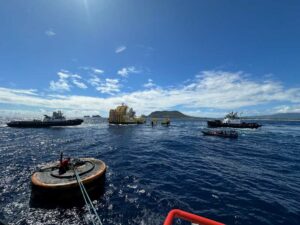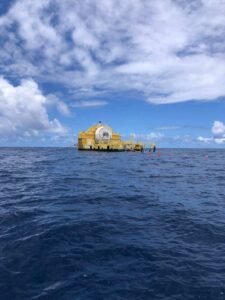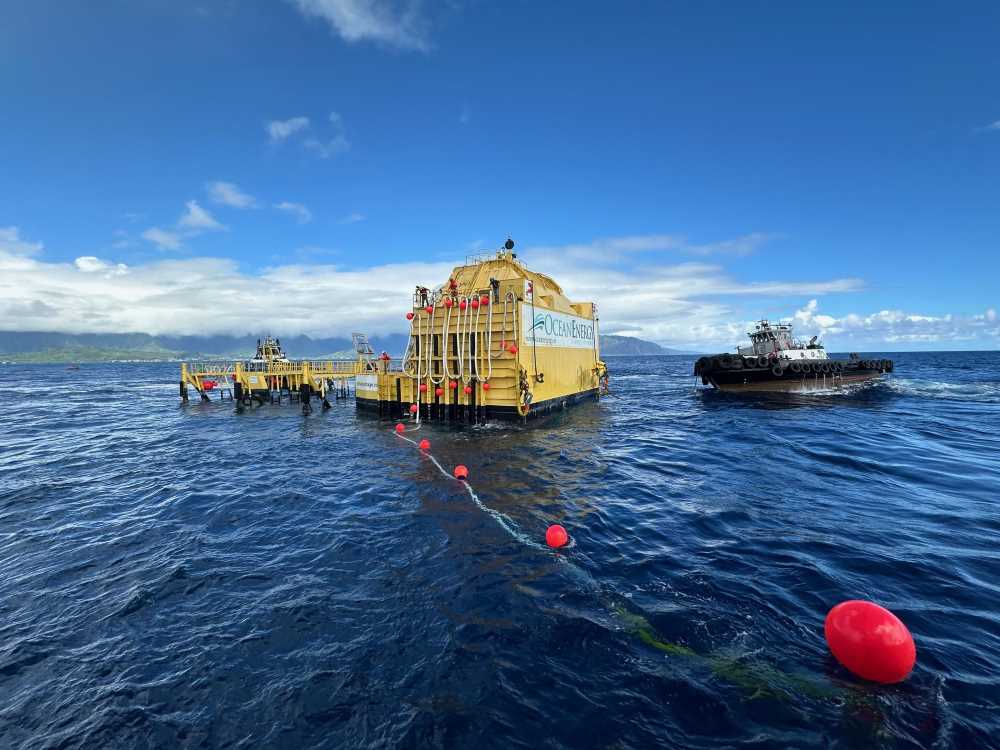The world’s first-ever grid-scale wave energy device has been installed at the US Navy’s Wave Energy Test Site (WETS) on the windward coast of the Hawaiian Island of Oahu.
Funded by the US Department of Energy and developed by the Irish energy company Ocean Energy USA LLC, the massive energy harvesting device they call OE-35 is designed to capture the energy generated by ocean waves, sometimes referred to as “blue energy,” and convert it into usable electricity.
The novel power generator will undergo several tests before being connected to the Hawaiian energy grid. Once connected, it will represent the largest wave energy harvesting device currently in use anywhere in the world, according to a press release announcing the placement of OE-35.
“Following over a decade and a half of design, trials, testing, and building, we are excited finally to be able to take this major step towards commercialization with our world-class OE-35 device,” said Professor Tony Lewis, Ocean Energy’s Chief Technology Officer.


Wave Energy Harvesting Seeing Renewed Interest
While renewable energy technologies like solar and wind power have outpaced the alternatives, the ability to capture the energy generated by ocean waves and convert it into electricity was first tested in the mid-twentieth century. Unfortunately, low performance and difficulty in placement and use have limited its adoption compared to land-based energy solutions.
More recently, renewed interest in wave energy harvesting, especially in coastal locations, has begun to drive improvements. Earlier this year, The Debrief reported on a wave energy harvesting “hack” developed by scientists that improved the performance of standard triboelectric nanogenerators (TENG) simply by repositioning the electrode within the device. That work showed increases in energy output over previous designs, ranging from 2 to 3.5 times.
In China, another team of researchers used TENGs to develop a “rain panel” that generates electrical energy from the impact of raindrops on its surface. While not commercially available, these types of devices could offer a whole new way to capture and use energy.


OE-35 Potential rated Capacity of 1.25 Megawatts
Unlike some other wave energy harvesting systems, which are comprised of a chain of smaller modules, the OE-35 is a single, massive 826-ton wave energy converter buoy. According to details released by the company, the OE-35 measures 125 x 59 feet with a draft of 30 feet. When operating at full capacity, this first-of-its-class energy harvester boasts a “potential rated capacity” of 1.25 megawatts.
For its current round of testing, the offshore device is located north of Mōkapu Peninsula, at the WETS site in Kaneohe Bay, after it was towed from Honolulu on Friday, July 19. While few details are available on the nature of the system’s upcoming tests, the company did say once they have determined it is ready for deployment, they plan to connect it to the Hawaiian energy grid via undersea cables “in the coming weeks.”
Funded by the US Department of Energy’s Office of Energy Efficiency and Renewable Energy and the Sustainable Energy Authority of Ireland (SEAI), the $12 million project is hailed by the company as a major step forward for renewable energy harvesting. If it passes the test, it will be the first grid-scale system using this technology to be deployed. It could also represent an enticing new option for governments and companies looking to generate power with a much lower carbon footprint than traditional power generation technologies.
“This internationally significant project couldn’t come online at a more critical time for the US and Ireland as the World needs to accelerate the pace of decarbonization with new and innovative technologies,” said Lewis.
Christopher Plain is a Science Fiction and Fantasy novelist and Head Science Writer at The Debrief. Follow and connect with him on X, learn about his books at plainfiction.com, or email him directly at christopher@thedebrief.org.

